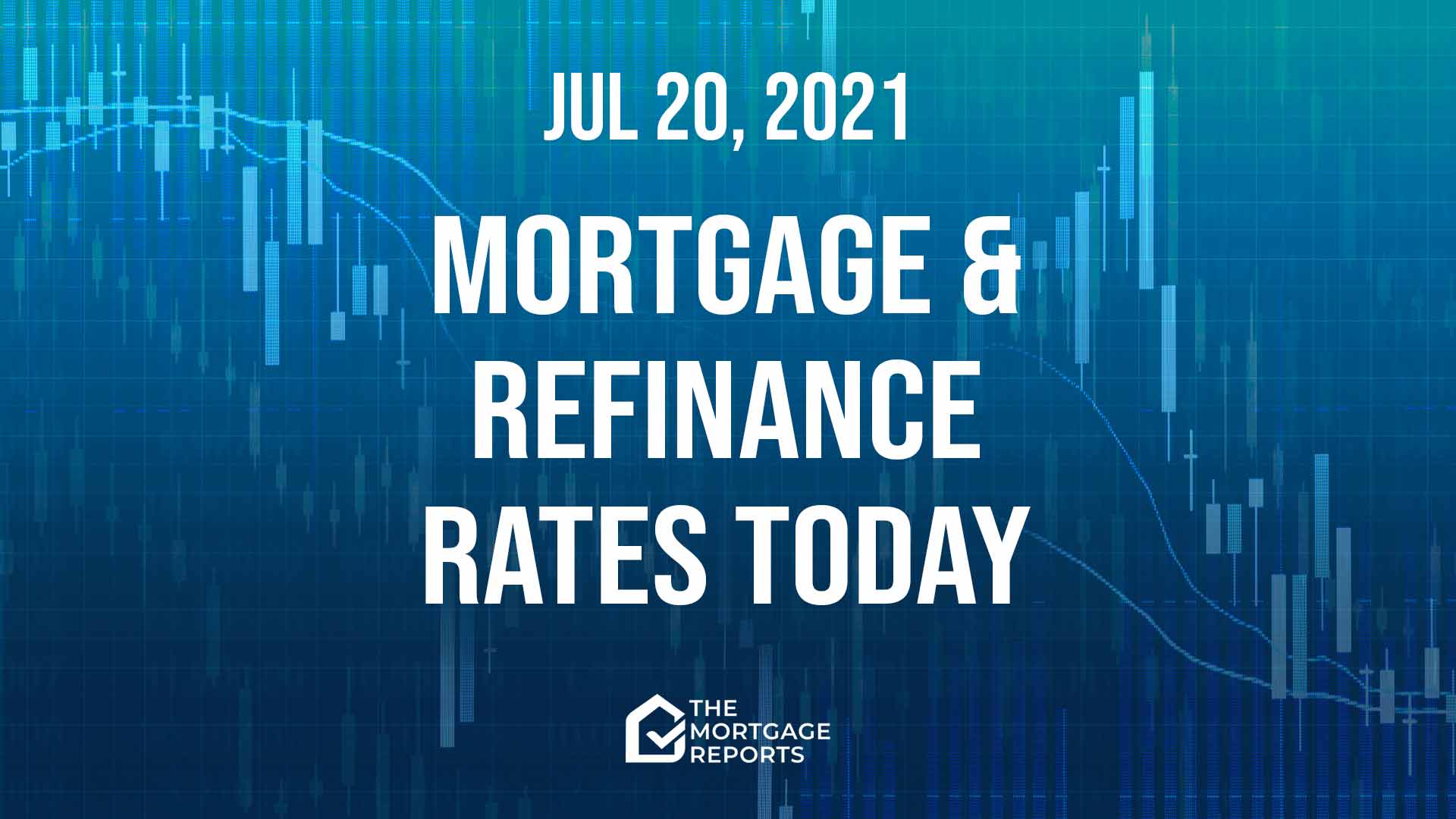
Today’s mortgage and refinance rates
Average mortgage rates fell appreciably yesterday. That’s four consecutive business days of falls. And they’re now exceptionally low; not a million miles from their all-time low.
And they may not be finished yet. Because, judging from early activity in key markets, those falls may be slowing rather than stopping. And mortgage rates today look likely to edge modestly lower. But, overnight, markets were pointing to a small rise so things are far from stable and could change as the hours pass.
Find and lock a low rate (Jul 20th, 2021)Current mortgage and refinance rates
| Program | Mortgage Rate | APR* | Change |
|---|---|---|---|
| Conventional 30 year fixed | |||
| Conventional 30 year fixed | 2.686% | 2.686% | -0.12% |
| Conventional 15 year fixed | |||
| Conventional 15 year fixed | 1.99% | 1.99% | -0.14% |
| Conventional 20 year fixed | |||
| Conventional 20 year fixed | 2.375% | 2.375% | -0.12% |
| Conventional 10 year fixed | |||
| Conventional 10 year fixed | 1.851% | 1.858% | -0.11% |
| 30 year fixed FHA | |||
| 30 year fixed FHA | 2.563% | 3.214% | Unchanged |
| 15 year fixed FHA | |||
| 15 year fixed FHA | 2.397% | 2.997% | -0.08% |
| 5/1 ARM FHA | |||
| 5/1 ARM FHA | 2.5% | 3.213% | Unchanged |
| 30 year fixed VA | |||
| 30 year fixed VA | 2.25% | 2.421% | Unchanged |
| 15 year fixed VA | |||
| 15 year fixed VA | 2.25% | 2.571% | Unchanged |
| 5/1 ARM VA | |||
| 5/1 ARM VA | 2.5% | 2.392% | Unchanged |
| Rates are provided by our partner network, and may not reflect the market. Your rate might be different. Click here for a personalized rate quote. See our rate assumptions here. | |||
COVID-19 mortgage updates: Mortgage lenders are changing rates and rules due to COVID-19. To see the latest on how coronavirus could impact your home loan, click here.
Should you lock a mortgage rate today?
Read on for reasons why mortgage rates are currently so unpredictable. Unfortunately, that makes both locking and floating risky.
Those of us who have been predicting higher mortgage rates (virtually all experts and observers) have so far been proved comprehensively wrong. But the fact that we’ve misread the timing doesn’t necessarily mean they won’t rise soon. And, as long as the forces that should be driving these rates higher remain strong, I have to stick to my long-held view. However, I’m less confident than I once was.
So, although they must be interpreted within that context, my personal rate lock recommendations must remain:
- LOCK if closing in 7 days
- LOCK if closing in 15 days
- LOCK if closing in 30 days
- LOCK if closing in 45 days
- LOCK if closing in 60 days
However, I don’t claim perfect foresight. And your personal analysis could turn out to be as good as mine — or better. So you might choose to be guided by your instincts and your personal tolerance for risk.
Market data affecting today’s mortgage rates
Here’s a snapshot of the state of play this morning at about 9:50 a.m. (ET). The data, compared with roughly the same time yesterday, were:
- The yield on 10-year Treasury notes fell to 1.16% from 1.21%. (Good for mortgage rates.) More than any other market, mortgage rates normally tend to follow these particular Treasury bond yields, though less so recently
- Major stock indexes were nearly all rising shortly after opening. (Bad for mortgage rates.) When investors are buying shares they’re often selling bonds, which pushes prices of those down and increases yields and mortgage rates. The opposite may happen when indexes are lower
- Oil prices fell to $66.08 from $68.72 a barrel. (Good for mortgage rates*.) Energy prices play a large role in creating inflation and also point to future economic activity.
- Gold prices rose to $1,826 from $1,810 an ounce. (Neutral for mortgage rates*.) In general, it’s better for rates when gold rises, and worse when gold falls. Gold tends to rise when investors worry about the economy. And worried investors tend to push rates lower
- CNN Business Fear & Greed index — edged lower to 16 from 19 out of 100. (Good for mortgage rates.) “Greedy” investors push bond prices down (and interest rates up) as they leave the bond market and move into stocks, while “fearful” investors do the opposite. So lower readings are better than higher ones
Caveats about markets and rates
Before the pandemic and the Federal Reserve’s interventions in the mortgage market, you could look at the above figures and make a pretty good guess about what would happen to mortgage rates that day. But that’s no longer the case. We still make daily calls. And are usually right. But our record for accuracy won’t achieve its former high levels until things settle down.
So use markets only as a rough guide. Because they have to be exceptionally strong or weak to rely on them. But, with that caveat, so far mortgage rates today look likely to fall modestly. But be aware that “intraday swings” (when rates change direction during the day) are a common feature right now.
Find and lock a low rate (Jul 20th, 2021)
Important notes on today’s mortgage rates
Here are some things you need to know:
- Typically, mortgage rates go up when the economy’s doing well and down when it’s in trouble. But there are exceptions. Read ‘How mortgage rates are determined and why you should care
- Only “top-tier” borrowers (with stellar credit scores, big down payments and very healthy finances) get the ultralow mortgage rates you’ll see advertised
- Lenders vary. Yours may or may not follow the crowd when it comes to daily rate movements — though they all usually follow the wider trend over time
- When daily rate changes are small, some lenders will adjust closing costs and leave their rate cards the same
- Refinance rates are typically close to those for purchases. But some types of refinances are higher following a regulatory change
So there’s a lot going on here. And nobody can claim to know with certainty what’s going to happen to mortgage rates in coming hours, days, weeks, or months.
Are mortgage and refinance rates rising or falling?
Today and soon
Market movements over the last couple of business days have been unusually sharp. A week ago, the yield on 10-year Treasury notes (which mortgage rates often shadow) closed at 1.42%. But, yesterday evening, they closed at 1.21%. And this morning, they stood at 1.15%. Those are huge differences.
You can ascribe those falls to pure emotion: namely, fear. Now, there are solid grounds for some fear over the potential damage that COVID-19 could cause to the global economy. But, if some new medical statistic or economic number triggered recent falls in Treasury yields, mortgage rates and stocks, it was one that passed me by. Jim Reid of Deutsche Bank seems to concur, according to this morning’s Guardian:
Unlike some previous Covid-related sell-offs (or vaccine rallies indeed), there didn’t seem to be a single trigger point behind yesterday’s rout, which instead looked to be the culmination of rising fears that a return to ‘normality’ could be quite a bit further out than many had hoped a few months back.
— Guardian, “Business Today” e-newsletter, July 20, 2021
Herd behavior
So, it looks likely that investors suddenly took fright at a risk that has been in plain sight for months. And, in spite of the myth of perfect markets, they’re as vulnerable to herd behavior as consumers are when they panic buy toilet paper.
The problem is that such an emotion-driven herd mentality is inherently fickle and unpredictable. Already, it’s looking as if mortgage rates might fall much more slowly today. And I can’t make the call as to whether they’ll bounce back further in the coming days (or weeks or months) or drop again. I doubt anyone can, least of all those in the herd.
Read Saturday’s weekend edition, for more background.
Mortgage rates and inflation: Why are rates going up?
Recently
Over much of 2020, the overall trend for mortgage rates was clearly downward. And a new, weekly all-time low was set on 16 occasions last year, according to Freddie Mac.
The most recent weekly record low occurred on Jan. 7, when it stood at 2.65% for 30-year fixed-rate mortgages. But then the trend reversed and rates rose.
However, those rises were mostly replaced by falls in April and since, though only small ones. Freddie’s July 15 report puts that weekly average at 2.88% (with 0.7 fees and points), down from the previous week’s 2.90%. And it’s highly likely they’ll be lower still come Thursday’s release.
Expert mortgage rate forecasts
Looking further ahead, Fannie Mae, Freddie Mac and the Mortgage Bankers Association (MBA) each has a team of economists dedicated to monitoring and forecasting what will happen to the economy, the housing sector and mortgage rates.
And here are their current rates forecasts for the remaining quarters of 2021 (Q3/21 and Q4/21) and the first two quarters of 2022 (Q1/22 and Q2/22).
The numbers in the table below are for 30-year, fixed-rate mortgages. Fannie’s were updated on July 19, Freddie’s on July 15 and the MBA’s on June 18.
| Forecaster | Q3/21 | Q4/21 | Q1/22 | Q2/22 |
| Fannie Mae | 3.0% | 3.1% | 3.2% | 3.2% |
| Freddie Mac | 3.3% | 3.4% | 3.5% | 3.6% |
| MBA | 3.2% | 3.5% | 3.7% | 3.9% |
However, given so many unknowables, the current crop of forecasts might be even more speculative than usual.
Find your lowest rate today
Some lenders have been spooked by the pandemic. And they’re restricting their offerings to just the most vanilla-flavored mortgages and refinances.
But others remain brave. And you can still probably find the cash-out refinance, investment mortgage or jumbo loan you want. You just have to shop around more widely.
But, of course, you should be comparison shopping widely, no matter what sort of mortgage you want. As federal regulator the Consumer Financial Protection Bureau says:
Verify your new rate (Jul 20th, 2021)Shopping around for your mortgage has the potential to lead to real savings. It may not sound like much, but saving even a quarter of a point in interest on your mortgage saves you thousands of dollars over the life of your loan.



